
The Crompton Mill Historic District is a historic district encompassing a mill complex at 20 Remington Street, 53 and 65 Manchester Street in West Warwick, Rhode Island. The mill complex consists of a collection of mainly brick buildings, bounded by the Pawtuxet River and Pulaski, Remington, and Manchester Streets in the village of Crompton. The mill complex formerly extended across the river, but the complex on the west bank was destroyed by fire in 1992. The oldest elements of the complex are the dam site and some of the raceways that provided water power to the mills. The present dam was built in 1908, replacing an 1882 structure. The raceways were built in 1807, around the time of the first mill buildings. The stone Mill No. 1, built 1807, is believed to be the oldest stone mill building in the state. Most of the complex's buildings were built in the late 19th and early 20th centuries by the Providence Manufacturing Company and its successors. The mill was used for textile processing until 1946, when the Crompton Corporation ended production.

The Farwell Mill is an historic former mill complex at 244 Lisbon Street in Lisbon, Maine. Built in 1872, it is a fine example of a cotton mill built at the height of the Industrial Revolution. It was listed on the National Register of Historic Places in 1985. It is now residential housing.

The Webster Rubber Company Plant, formerly the Webster Woolen Mill No. 1-1/2, is an historic industrial site on Greene Street in Sabattus, Maine. Built in 1869 as a textile mill, it was a fixture of the town's economy well into the 20th century, and is good local example of industrial Italianate architecture. The property was listed on the National Register of Historic Places in 1989. In 2015, the property was vacant, and it was demolished in 2018.
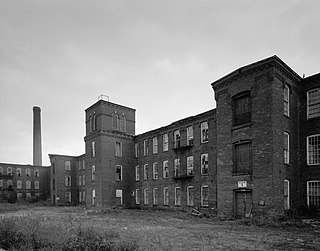
The Renfrew Mill No. 2 was a historic mill complex at 217 Columbia Street in Adams, Massachusetts. Most of its buildings were built between 1867 and 1878, and were brick buildings with Italianate styling. They were built by the Renfrew Manufacturing Company, a textile manufacturer, to replace an earlier complex further down Columbia Street that had been demolished. The property was acquired by the Arnold Print Works in 1928. The mill was the town's largest employer for much of the second half of the 19th century.

The Spicket Falls Historic District encompasses the historic industrial and commercial heart of Methuen, Massachusetts, and one of the lower Merrimack River's best-preserved 19th century mill complexes. It is centered on the falls of the Spicket River, from which the 19th century textile mills of Methuen derived their power. The historic district, listed on the National Register of Historic Places in 1984, includes commercial and civic buildings in and near Gaunt Square, the heart of the city, and along both sides of the Spicket River between Gaunt Square and the Boston and Maine Railroad tracks south of the river. It abuts the residential Pleasant-High Historic District, which lies to its east.

Sanford is a city in York County, Maine, United States. The population was 21,982 in the 2020 census, making it the seventh largest municipality in the state. Situated on the Mousam River, Sanford includes the village of Springvale. The city features many lakes in wooded areas which attract campers.

The Central Mills Historic District encompasses a historic mill complex on the Quinebaug River in central Southbridge, Massachusetts. Located at the corner of Foster and North Streets, the site consists of three brick buildings, the oldest of which has portions dating to 1837. Despite being extensively rebuilt in the early 20th century, the complex has an appearance that is more typical of 19th century mills.

The Saco–Pettee Machine Shops is a historic factory complex at 156 Oak Street in the Newton Upper Falls area of Newton, Massachusetts. Although the area has an industrial history dating to the early 19th century, the oldest buildings in this complex, consisting of about thirteen brick buildings, were built in 1892. The property, a major economic force in the development of Newton Upper Falls, was listed on the National Register of Historic Places in 1986. It was home to Clark's N.A., the North American home base to Clark's Shoes, makers of fine footwear, until they relocated to Waltham Ma. in October 2016.

The New Mill and Depot Building of the former Hawthorne Woolen Mill are located in Greenwich, Connecticut, United States. The two structures were built on an existing textile mill complex in the 1870s.

The Winooski Falls Mill District is located along the Winooski River in the cities of Winooski and Burlington, Vermont, in the United States of America. It encompasses a major industrial area that developed around two sets of falls on the river in the 19th century.

Davol Mills is a historic textile mill complex located at the corner of Plymouth Avenue and Rodman Street in Fall River, Massachusetts. It was built in 1867 and expanded in 1871. It was added to the National Register of Historic Places in 1983 as part of the Corky Row Historic District The red brick mills are unique in the city, built in the Second Empire style.
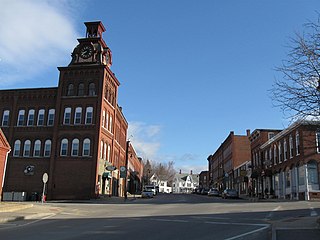
The Suncook Village Commercial–Civic Historic District encompasses the civic and commercial heart of Suncook, New Hampshire, a village on the Suncook River in Pembroke and Allenstown. The civic district is a 3-acre (1.2 ha) area on the Pembroke side of the river, adjacent to the Pembroke Mill, a site that had seen industrial use since the 18th century. The district includes 21 commercial buildings, 19 of which are historically significant. The district was listed on the National Register of Historic Places in 2005.

The Jaffrey Mills is a historic mill complex at 41 Main Street, in the central business district of Jaffrey, New Hampshire. It consists of a connected series of primarily brick buildings flanking the Contoocook River just north of Main Street. Its oldest buildings, the original mill and office building, are on the west side of the river. They were built in 1868, and feature mansard roofs and banded dentil brick cornices. The mill building has a tower that originally sported a cupola, but this was removed early in the 20th century. In 1872 the building on the east side was built, and the two sides joined by timber-frame bridges were added in 1897, at the same time the east building was extended northward. Later additions to the north of the east building include a storage area and a loading dock. The mill complex, the only 19th-century industrial complex of its type to be built in Jaffrey, was listed on the National Register of Historic Places in 1982. It has been converted into residences.

The Cocheco Mills comprise a historic mill complex in the heart of Dover, New Hampshire. The mills occupy a bend in the Cochecho River that has been site of cotton textile manufacturing since at least 1823, when the Dover Manufacturing Company supplanted earlier sawmills and gristmills. The present mill buildings were built between the 1880s and the early 20th century, and were listed on the National Register of Historic Places in 2014.
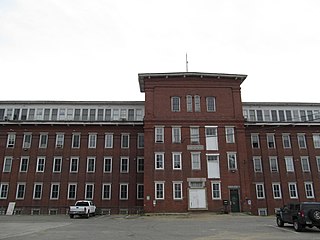
The Salmon Falls Mill Historic District encompasses a historic mill complex on Front Street in Rollinsford, New Hampshire. The complex includes four major structures and seven smaller ones, on about 14 acres (5.7 ha) of land along the Salmon Falls River. They were built between about 1840 and the mid-1860s, and have an unusual architectural unity, for additions made to the buildings were done with attention to matching design elements from the existing structures. The Number 2 Mill, built in 1848, was an early location where a turbine was used instead of a waterwheel to provide power to the mill machinery. The district was listed on the National Register of Historic Places in 1980.

The American Woolen Company Foxcroft Mill or Mayo & Son Woolen Mill is a group of seven historic buildings and three structures on East Main Street in downtown Dover-Foxcroft, Maine. The district is located on 2.77 acres (1.12 ha). The Foxcroft Mill is located on the west side of the Piscataquis River, which flows through downtown Dover-Foxcroft. The buildings were built between 1844 and 1941, and have been listed on the National Register of Historic Places.

Blackstone River Valley National Historical Park is a National Park Service unit in the states of Rhode Island and Massachusetts. The park was created for the purpose of preserving, protecting, and interpreting the industrial heritage of the Blackstone River Valley and the urban, rural, and agricultural landscape of that region. The Blackstone River Valley was the site of some of the earliest successful textile mills in the United States, and these mills contributed significantly to the earliest American Industrial Revolution. The subsequent construction of the Blackstone Canal, a few years after the successful completion of the Erie Canal, helped to sustain the region's industrial strength.
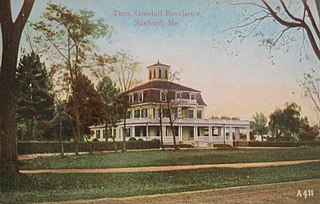
The Thomas Goodall House is a historic house near 938 Main Street in Sanford, Maine. It was built in 1871 for Thomas Goodall, owner of the local Goodall Mill, one of the region's largest employers in the late 19th century. Retaining many Second Empire details from its original construction, it underwent significant Colonial Revival alterations by Goodall's son, Eugene, early in the 20th century. The house was listed on the National Register of Historic Places in 1975.
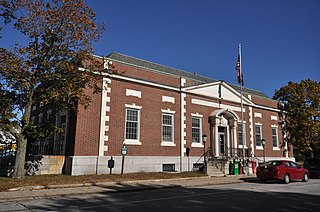
The U.S. Post Office-Sanford Maine is the main post office of Sanford, Maine. It is located at 28 School Street, near the city's central business district. Built in 1932 and enlarged to include other federal offices in 1965, it is an architecturally distinguished building with Classical and Colonial Revival features. The building was listed on the National Register of Historic Places in 1986.
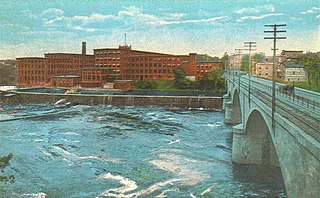
The Lockwood Mill Historic District encompasses the only major 19th-century mill complex in Waterville, Maine. Located south of the city's downtown, it was designed by Amos D. Lockwood, a nationally known industrial designer of the period. Its #2 building was for 45 years home to the Hathaway Shirt Company. It was listed on the National Register of Historic Places in 2007.
























